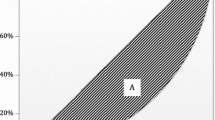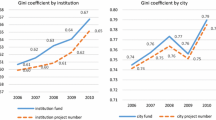Abstract
Drawing on a database of the competitive research funds in the Japanese academia, this study examines the distribution of research grants at the university and individual levels. The data indicates high inequality at the university level and slightly lower inequality at the individual level. Over the last three decades, the total grant budget has greatly increased and an increasing number of researchers have received the funds. Simultaneously, large-size grants have become more common and multiple awarding (i.e., one researcher receives more than one grant simultaneously) has become more frequent. These changes taken together, the level of inequality has not been changed substantially. The extent of inequality largely differs between scientific fields; especially high in basic natural sciences and relatively low in social sciences. A close examination of inequality over researchers’ career indicates different patterns of transition between fields and cohorts. Finally, both at the university and individual levels, the funding distribution is found more unequal than the distribution of publications as an output indicator.






Similar content being viewed by others
Notes
Source: School Basic Survey conducted by MEXT.
Source: Japan Society for the Promotion of Science (http://www.jsps.go.jp/j-grantsinaid/index.html).
The general information of GIA is given in the MEXT website (http://www.mext.go.jp/a_menu/shinkou/hojyo/main5_a5.htm).
As of 2008, there are 44 competitive funding systems. Some of them are individual-level funds for university research, while others are awarded to institutions, primarily focus on industrial research, or aim at education.
National institute of informatics (http://kaken.nii.ac.jp/en/).
I examined the ratio of grantees in all full and associate professors in the University of Tokyo (ranked first). After excluding those who have no publication, part-time employees (many of them are from industry), and apparent non-researchers, 95% or more of professors have obtained the GIA grants regardless of scientific fields.
A PI is the researcher who supervises a certain project. In most projects, there is only one PI, but for large projects, there may be more than one PI. In such cases, grant amount is divided by the number of PIs to calculate the per-PI amount.
In fact, the government mentions that the average grant size has been decreasing since 2002 (http://www.mext.go.jp/a_menu/shinkou/hojyo/1289168.htm).
For example, if a researcher received one grant from 1993 to 1995 and another grant from 1995 to 1997, this researcher is regarded as a multiple awardee in 1995.
In Japan, typical laboratories consist of one full professor, one associate professor, a few junior staff (assistant professors, postdoctoral researchers, etc.), and students, where full and associate professors control the management of the laboratory and often secure research funds for other staff.
In 2005, approximately 4,000 full and associate professors received two or more grants as a PI, which accounts for 16% of all the professors who received at least one grant in the year. I ignored non-grantees in this analysis because the true number of all researchers is not known. If all professors in all universities are considered (which include non-researchers), the ratio drops to 5.4%.
I use 5 years in the following analysis. The government regards 5 years as a standard term of research. The acceptance rate of GIA has been approximately 25%, so most applicants are supposed to receive at least one grant in 5 years if multiple awarding is sufficiently limited.
For the top seven universities, faculty members who received no grant are taken into consideration. They account for 16% of all faculty members in 2001–2005. On the other hand, for all universities non-grantees are ignored. Note that this different definition of populations results in larger inequality in the top seven universities than in all universities.
The field of each researcher is determined on the basis of the field most frequently assigned to their past grants.
I chose the researchers who have 25 or more years of career. That is, I excluded researchers whose career ends before 25 years; such as those moved to industry or education-oriented universities. If these researchers were included, the inequality in later career stages would be higher.
For validation, I counted the number of publications whose affiliation includes each national university using Web of Science, which resulted in a similar level of Gini coefficient.
References
Asonuma, A. (2002). Finance reform in Japanese higher education. Higher Education, 43, 109–126.
Baumeister, A. A., & Bacharach, V. R. (1997). “Big” versus “little” science: Comparative analysis of program projects and individual research grants. American Journal on Mental Retardation, 102, 211–227.
Burrell, Q. L. (1991). The bradford distribution and the Gini index. Scientometrics, 21, 181–194.
Center for National University Finance and Management. (2009). Research on tuition and expenses for basic education and research at national universities. Japan: Chiba.
Center for National University Finance and Management. (2010). Research report of the finance and administration of national universities. Chiba, Japan.
Crespi, G. A., & Geuna, A. (2008). An empirical study of scientific production: A cross country analysis, 1981–2002. Research Policy, 37, 565–579.
Denavas-Walt, C., Proctor, B. D., & Smit, J. C. (2009). Income, poverty, and health insurance coverage in the United States: 2008. Washington, DC: United States Census Bureau.
Dorfman, R. (1979). Formula for the Gini coefficient. Review of Economics and Statistics, 61, 146–149.
Etzkowitz, H., & Leydesdorff, L. (2000). The dynamics of innovation: From national systems and “Mode 2” to a triple helix of university-industry-government relations. Research Policy, 29, 109–123.
Geuna, A., & Martin, B. R. (2003). University research evaluation and funding: An international comparison. Minerva, 41, 277–304.
Halffman, W., & Leydesdorff, L. (2010). Is inequality among universities increasing? Gini coefficients and the elusive rise of elite universities. Minerva, 48, 55–72.
Hand, E. (2008). 222 NIH grants: 22 researchers. Nature, 452, 258.
Hicks, D. M., & Katz, S. (2009). Toward a science policy framework addressing extreme inequity and resource distribution in research. http://works.bepress.com/sylvan_katz/1.
Kneller, R. (2010). The changing governance of Japanese public science. In R. Whitley, J. Gläser, & L. Engwall (Eds.), Reconfiguring knowledge production: Changing authority relations in the sciences and their consequences for intellectual innovation. Oxford: Oxford University Press.
Kotchen, T. A., Lindquist, T., Malik, K., & Ehrenfeld, E. (2004). NIH peer review of grant applications for clinical research. Journal of the American Medical Association, 291, 836–843.
Lotka, A. J. (1926). The frequency distribution of scientific productivity. Journal of the Washington Academy of Science, 16, 317–323.
MEXT Subcommittee of Academic Science. (2003). What big science should be. Tokyo, Japan: The Ministry of Education, Culture, Sports, Science & Technology.
MEXT Subcommittee of Academic Science. (2008). The direction of urgent measures on Grant-in-Aid for Scientific Research: The summary of discussion Part 2. Tokyo, Japan: The Ministry of Education, Culture, Sports, Science & Technology.
National Institute of Science and Technology Policy. (2009). Collecting the data study for evaluating the achievement of the S&T Basic Plans. NISTEP Report, 133. Tokyo, Japan: NISTEP.
OECD. (1997). The evaluation of scientific research: Selected experiences. Paris, France: OECD.
Ray, D. (1998). Development economics. Princeton, NJ: Princeton University Press.
Wadman, M. (1997). NIH to abandon young investigator grants. Nature, 390, 211.
Zitt, M., Barre, R., Sigogneau, A., & Laville, F. (1999). Territorial concentration and evolution of science and technology activities in the European Union: A descriptive analysis. Research Policy, 28, 545–562.
Acknowledgments
I appreciate Prof. Aldo Geuna at the University of Turin and Prof. Diana Hicks and Prof. John P. Walsh at Georgia Institute of Technology for their insightful comments. I thank Prof. Hideaki Takeda at the National Institute of Informatics for providing the grant database. This study is supported by Postdoctoral Fellowships for Research Abroad of the Japan Society for the Promotion of Science.
Author information
Authors and Affiliations
Corresponding author
Appendix
Appendix
See Fig. 7.
Growth of university system by field: a total budget, b number of grants, and c number of grantees. a The amount of grants awarded to researchers is summed up for each field. The price level is adjusted by the GDP deflator (the base year is 2000). c Since the statistics for university researchers do not distinguish scientific fields, I present the number of grantees (instead of all researchers) in each field
Rights and permissions
About this article
Cite this article
Shibayama, S. Distribution of academic research funds: a case of Japanese national research grant. Scientometrics 88, 43–60 (2011). https://doi.org/10.1007/s11192-011-0392-z
Received:
Published:
Issue Date:
DOI: https://doi.org/10.1007/s11192-011-0392-z





